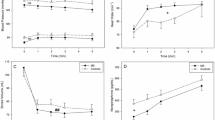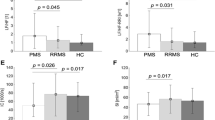Abstract
Objective
The aim of this study was to determine the prevalence of autonomic dysfunction using the composite autonomic scoring scale (CASS) and heart rate variability (HRV) in patients with clinically isolated syndrome (CIS) and to correlate autonomic dysfunction with other measures of MS disease activity.
Methods
CASS, HRV and plasma catecholamines during supine and tilted phase were performed in 104 CIS patients. MRI findings were analyzed for total number of lesions and the presence of brainstem and cervical spinal cord lesions.
Results
Autonomic dysfunction (CASS >1) was present in 59.8 % of patients, parasympathetic dysfunction in 5 %, sympathetic in 42.6 % and sudomotor in 32.7 % of patients. Patients with autonomic dysfunction on CASS had lower level of norepinephrine in the supine position compared to patients without autonomic dysfunction (1.06 ± 0.53 vs. 1.37 ± 0.86, p = 0.048). The CASS score showed positive correlation with s-HF (r = 0.226, p = 0.031), s-SDNN (r = 0.221, p = 0.035), t-HF (r = 0.225, p = 0.032), and t-HFnu (r = 0.216, p = 0.04), and a negative correlation with t-LF/HF (r = −0.218, p = 0.038). More patients with MRI brainstem lesions had a positive adrenergic index (p = 0.038). Patients with MRI brainstem lesions also had a lower t-SDNN (26.2 ± 14.2 vs. 32 ± 13.3, p = 0.036) and a lower t-LF (median 415.0 vs. 575.5, p = 0.018) compared to patients without these lesions. Patients with adrenergic index ≥1 had a significantly higher standing heart rate compared to patients with an adrenergic index of 0 (96 ± 13.5 vs. 90 ± 12, p = 0.032).
Conclusion
Autonomic (primarily sympathetic) dysfunction is present in a large proportion of early MS patients and it seems to be related to brainstem involvement.

Similar content being viewed by others
Abbreviations
- ANS:
-
Autonomic nervous system
- CIS:
-
Clinically isolated syndrome
- MS:
-
Multiple sclerosis
- MRI:
-
Magnetic resonance imaging
- CASS:
-
Composite autonomic scoring scale
- HRV:
-
Heart rate variability
- QSART:
-
Quantitative sudomotor axon reflex test
- TFM:
-
Task force monitor
- HF:
-
High frequency
- LF:
-
Low frequency
- nu:
-
Normalized units
- HR:
-
Heart rate
- sBP:
-
Systolic blood pressure
- dBP:
-
Diastolic blood pressure
- BS:
-
Brainstem
References
Brownlee WJ, Miller DH (2014) Clinically isolated syndromes and the relationship to multiple sclerosis. J Clin Neurosci 21:2065–2071
Adamec I, Habek M (2013) Autonomic dysfunction in multiple sclerosis. Clin Neurol Neurosurg 115(Suppl 1):S73–S78
Racosta JM, Sposato LA, Morrow SA, Cipriano L, Kimpinski K, Kremenchutzky M (2015) Cardiovascular autonomic dysfunction in multiple sclerosis: a meta-analysis. Mult Scler Relat Disord 4:104–111
Low PA (1993) Composite autonomic scoring scale for laboratory quantification of generalized autonomic failure. Mayo Clin Proc 68:748–752
Crnošija L, Adamec I, Lovrić M et al (2016) Autonomic dysfunction in clinically isolated syndrome suggestive of multiple sclerosis. Clin Neurophysiol 127:864–869
Flachenecker P, Reiners K, Krauser M, Wolf A, Toyka KV (2001) Autonomic dysfunction in multiple sclerosis is related to disease activity and progression of disability. Mult Scler 7:327–334
Novak P (2011) Quantitative autonomic testing. J Vis Exp (53).doi:10.3791/2502
Freeman R (2006) Assessment of cardiovascular autonomic function. Clin Neurophysiol 117:716–730
Tarvainen MP, Niskanen JP, Lipponen JA, Ranta-Aho PO, Karjalainen PA (2014) Kubios HRV–heart rate variability analysis software. Comput Methods Programs Biomed 113:210–220
Malik M, Bigger JT, Camm AJ et al (1996) Heart rate variability. Standards of measurement, physiological interpretation, and clinical use. Task Force of the European Society of Cardiology and the North American Society of Pacing and Electrophysiology. Eur Heart J 17:354–381
Sztajzel J (2004) Heart rate variability: a noninvasive electrocardiographic method to measure the autonomic nervous system. Swiss Med Wkly 134:514–522
Nasseri K, Uitdehaag BM, van Walderveen MA, Ader HJ, Polman CH (1999) Cardiovascular autonomic function in patients with relapsing remitting multiple sclerosis: a new surrogate marker of disease evolution? Eur J Neurol 6:29–33
Saari A, Tolonen U, Pääkkö E, Suominen K, Pyhtinen J, Sotaniemi K, Myllylä V (2004) Cardiovascular autonomic dysfunction correlates with brain MRI lesion load in MS. Clin Neurophysiol 115:1473–1478
Zoukos Y, Thomaides T, Pavitt DV, Leonard JP, Cuzner ML, Mathias CJ (1992) Up-regulation of beta-adrenoceptors on circulating mononuclear cells after reduction of central sympathetic outflow by clonidine in normal subjects. Clin Auton Res 2:165–170
Polak PE, Kalinin S, Feinstein DL (2011) Locus coeruleus damage and noradrenaline reductions in multiple sclerosis and experimental autoimmune encephalomyelitis. Brain 134:665–677
Rajda C, Bencsik K, Fuvesi J, Seres E, Vecsei L, Bergquist J (2006) The norepinephrine level is decreased in the lymphocytes of long-term interferon-beta-treated multiple sclerosis patients. Mult Scler 12:265–270
Sternberg Z (2016) Impaired neurovisceral integration of cardiovascular modulation contributes to multiple sclerosis morbidities. Mol Neurobiol. doi:10.1007/s12035-015-9599-y
Davis SL, Wilson TE, Vener JM, Crandall CG, Petajan JH, White AT (1985) Pilocarpine-induced sweat gland function in individuals with multiple sclerosis. J Appl Physiol 2005(98):1740–1744
Gotoh F, Komatsumoto S, Araki N, Gomi S (1984) Noradrenergic nervous activity in migraine. Arch Neurol 41:951–955
Gomi S, Gotoh F, Komatsumoto S, Ishikawa Y, Araki N, Hamada J (1989) Sweating function and retinal vasomotor reactivity in migraine. Cephalalgia 9:179–185
Vasheghani-Farahani A, Sahraian MA, Darabi L, Aghsaie A, Minagar A (2011) Incidence of various cardiac arrhythmias and conduction disturbances due to high dose intravenous methylprednisolone in patients with multiple sclerosis. J Neurol Sci 309:75–78
Rossi S, Rocchi C, Studer V, Motta C et al (2015) The autonomic balance predicts cardiac responses after the first dose of fingolimod. Mult Scler 21:206–216
Hilz MJ, Intravooth T, Moeller S, Wang R, Lee DH, Koehn J, Linker RA (2015) Central autonomic dysfunction delays recovery of fingolimod induced heart rate slowing. PLoS One 10:e0132139
Huang M, Jay O, Davis SL (2015) Autonomic dysfunction in multiple sclerosis: implications for exercise. Auton Neurosci 188:82–85
Thomaides TN, Zoukos Y, Chaudhuri KR, Mathias CJ (1993) Physiological assessment of aspects of autonomic function in patients with secondary progressive multiple sclerosis. J Neurol 240:139–143
Pepin EB, Hicks RW, Spencer MK, Tran ZV, Jackson CG (1996) Pressor response to isometric exercise in patients with multiple sclerosis. Med Sci Sports Exerc 28:656–660
Senaratne MP, Carroll D, Warren KG, Kappagoda T (1984) Evidence for cardiovascular autonomic nerve dysfunction in multiple sclerosis. J Neurol Neurosurg Psychiatry 47:947–952
Cohen JA, Hossack KF, Franklin GM (1989) Multiple sclerosis patients with fatigue: relationship among temperature regulation, autonomic dysfunction, and exercise capacity. Neurorehabil Neural Repair 3:193–198
Huang M, Morris NB, Jay O, Davis SL. Thermoregulatory dysfunction in multiple sclerosis patients during moderate exercise in a thermoneutral environment. FASEB J 2014;28 (Supplement 1),1104.17
Author information
Authors and Affiliations
Corresponding author
Ethics declarations
Financial and competing interest disclosure
None of the authors have relevant affiliations or financial involvement with any organization or entity with a financial interest in or financial conflict with the subject matter or materials discussed in the manuscript. This includes employment, consultancies, honoraria, stock ownership or options, expert testimony, grants or patents received or pending, or royalties. No writing assistance was utilized in the production of this manuscript.
Funding
This study was funded by the Installation Research project HRZZ UIP-11-2013–2622 of the Croatian Science Foundation.
Rights and permissions
About this article
Cite this article
Habek, M., Crnošija, L., Lovrić, M. et al. Sympathetic cardiovascular and sudomotor functions are frequently affected in early multiple sclerosis. Clin Auton Res 26, 385–393 (2016). https://doi.org/10.1007/s10286-016-0370-x
Received:
Accepted:
Published:
Issue Date:
DOI: https://doi.org/10.1007/s10286-016-0370-x




